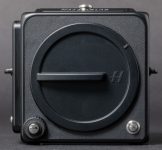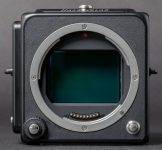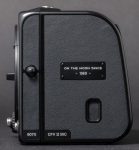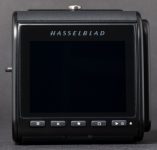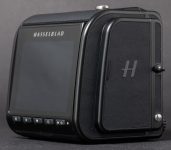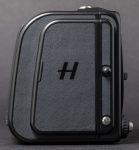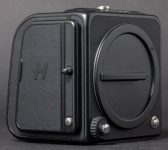Announced
Production type
Availability
System
Hasselblad X system cameras
Hasselblad 907X 50c Special Edition
Medium format AF digital mirrorless camera • Discontinued • Collectible
Specification
| Format: | |
| Medium format 44x33 | |
Imaging sensor: | 43.8 × 23.9mm CMOS sensor |
Resolution: | 8272 × 6200 - 51 MP |
Sensor-shift image stabilization: | - |
| Hasselblad X [18.14mm] | |
| Shutter: | |
Type: | In-lens leaf shutter |
| Exposure: | |
Exposure metering: | Through-the-lens (TTL), open-aperture |
Exposure modes: | Programmed Auto |
| Aperture-priority Auto | |
| Shutter-priority Auto | |
| Manual | |
| Physical characteristics: | |
Weight: | 845g |
Dimensions: | 102x93x84mm |
Manufacturer description #1
2019-07-18 - HASSELBLAD LAUNCHES THE 907X SPECIAL EDITION TO CELEBRATE 50 YEARS ON THE MOON
Commemorating the 50th anniversary of the historic Apollo 11 moon landing, Hasselblad proudly celebrates its role as the cameras chosen by NASA for space photography, and even more so, the cameras that documented the historical moment of the first humans on the Moon. In honour of this momentous occasion, Hasselblad launches the limited 907X Special Edition, which includes the 907X camera body and CFV II 50C digital back, both in matte black with commemorative “On the Moon Since 1969” anniversary text.
Considered one of the most iconic moments in history is the 1969 Apollo 11 mission to the Moon – an event so extraordinary that saw the first humans step off our planet and onto another celestial body. Taken down to the lunar surface, attached to astronaut Armstrong’s chest, was a silver Hasselblad Data Camera (HDC) fitted with a Zeiss Biogon 60mm ƒ/5,6 lens and 70mm film magazine which had never actually been tested in space before. A second black Hasselblad Electric Camera (HEC) with a Zeiss Planar 80mm ƒ/2,8 lens was used to shoot from inside the Eagle lunar module. A third black HEC was used by astronaut Michael Collins aboard the Command Module Columbia in lunar orbit. Standing up against the intense temperatures and lack of gravity in space, the Hasselblad cameras captured this once in a lifetime moment flawlessly, letting the rest of Earth see what astronauts Aldrin and Armstrong experienced on the Moon. The resulting images taken with the HDC and HEC have not only provided scientific insight but have proven to be legendary marvels recognized the world over. It was the HEC used by Collins that was taken back to Earth, while the HDC and HEC used on the lunar surface and lunar module were left on the Moon to meet narrow weight margins for successful return. As far as we know, they’ve been on the Moon since 1969. Hasselblad proudly celebrates being the camera that documented the historic Moon landing with the 907X Special Edition. The limited-edition kit includes the 907X camera body and CFV II 50C digital back, both in matte black, just as the HEC that made it back to Earth. On the digital back is the text “On the Moon Since 1969”, commemorating the HDC and HEC left behind on the lunar surface fifty years ago. Together, the 907X and CFV II 50C connect Hasselblad’s photographic history into one system. Coupling the CFV II 50C with Hasselblad’s smallest medium format camera body ever, the 907X, creates a highly compact mirrorless digital camera. This combination offers a truly distinct photographic experience, including the classic waist-level shooting style of the V System enabled by the CFV II 50C’s tilt screen. With the 907X attached to the CFV II 50C, the photographer gains access to all the high-quality XCD Lenses, providing autofocus and electronic exposure control. Coupled with the XH Adapter, all HC/HCD Lenses can be used on the 907X, along with XPan and V System Lenses in electronic shutter mode with the XPan and XV Lens Adapters, respectively. In addition, the 907X enables compatibility with a wide range of third-party adapters and lenses in electronic shutter mode. Reminiscent of the classic V System film magazine design, the modern CFV II 50C also works as a stand-alone digital back. Compatible with most V System cameras made from 1957 and onwards, the CFV II 50C can also be used on third party technical or view cameras.
Key features of the 907X Special Edition include:
- Large medium format 50MP CMOS sensor
- Up to 14 stops of dynamic range
- Captures 16-bit RAW images and full resolution JPEGs
- High-resolution 3.0-inch 920K dot touch and tilt screen
- Smooth live view experience with a high frame rate of 60fps
- Focus peaking, enabling more accurate focusing (especially advantageous on the manual-focused V System cameras)
- Intuitive user interface with swipe and pinch touch controls
- Internal battery slot with the option to recharge in-camera via the USB-C port (same battery used on the X System)
- Dual UHS-II SD card slots
- Integrated Wi-Fi and USB-C connection
- Portable workflow with Phocus Mobile 2 support
Continuing the celebration, Hasselblad releases a limited edition 50 Years on the Moon merchandise collection, including posters, t-shirts, patches and stickers that commemorate this historical anniversary.
Manufacturer description #2
On 20 July 1969, Astronauts Aldrin and Armstrong successfully landed on our lunar surface, becoming the first humans to step foot on the Moon. Apollo 11 was not only a huge milestone for NASA and space exploration but was also a defining moment for Hasselblad as the camera chosen to document this historic mission. Standing up against the intense temperatures and lack of gravity in space, the Hasselblad cameras captured this once in a lifetime moment flawlessly, letting the rest of Earth see what astronauts Aldrin and Armstrong experienced on the Moon. As the camera makers who enabled the capture of the iconic, legendary Moon landing photographs, we commemorate the 50th anniversary with the 907X Special Edition.
The limited-edition 907X Special Edition celebrates the anniversary of the first Moon landing and the Hasselblad cameras that documented this historic event, which were left behind on the lunar surface fifty years ago. The three cameras taken on the mission were a silver Hasselblad Data Camera (HDC), a black Hasselblad Electric Camera (HEC), and a third black HEC – the first camera was used by Astronaut Armstrong to shoot on the lunar surface, the second used from inside the Eagle lunar module, and the third used by Astronaut Michael Collins aboard the Command Module Columbia in lunar orbit. The HEC used by Collins was the one camera of the three that was brought back to Earth from the Apollo 11 mission.
The 907X Special Edition includes the 907X camera body and CFV II 50C digital back, both in matte black, just like the HEC used by Collins that made it back to Earth. On the digital back is the text “On the Moon Since 1969”, commemorating the HDC and HEC left behind on the lunar surface fifty years ago. Together, the 907X and CFV II 50C connect Hasselblad’s photographic history into one system. Photographers can then add any of Hasselblad's XCD lenses (sold separately) or support to V, H, or XPan systems through available lens adapters. The XCD 45 shown is not included with the 907X Special Edition.
Hasselblad’s smallest medium format camera body ever weighing in at only 206g, the 907X is extremely thin, lightweight and built to smoothly combine with the CFV II 50C, creating a highly compact photographic package. Connecting the 907X with the CFV II 50C enables shooting with a wide range of Hasselblad optics, including all XCD Lenses and all HC/HCD, V System and XPan Lenses via adapters.
The CFV II 50C digital back features a brilliant 50-megapixel CMOS medium format sensor, individually calibrated for excellent performance, with outstanding colour depth, a huge dynamic range of 14 stops and the ability to capture full size in-camera JPEG images. Hasselblad Natural Colour Solution technology is integrated into the camera’s system, delivering superb, true-to-life tones that match what the human eye sees. Ergonomically enhanced from the previous model, the CFV II 50C now has a touch and tilt rear display in addition to an internal battery slot, making it an even sleeker package. Also used as a stand-alone back, the CFV II 50C is compatible with most V System cameras from 1957 and onwards in addition to technical and view cameras.
The CFV II 50C celebrates Hasselblad’s design-centric heritage with its timeless look featuring a similar form factor as the original V System film magazines, but in matte black like the HEC that made it back Earth. Coupling the digital back with Hasselblad’s smallest medium format camera body ever, the 907X, creates a very sleek, compact package. Combining modern technology with classic aesthetics reminiscent of the Hasselblad SWC camera, the CFV II 50C and 907X give a nod to Hasselblad’s history combined with its renowned image quality.
The CFV II 50C digital back can be paired with most Hasselblad V System cameras made from 1957 and onwards in addition to technical cameras, making it easy to combine analog and digital shooting. When combined with the 907X camera body, the photographer gains access to the entire XCD Lens range, providing autofocus and autoexposure. Unlike the previous CFV models, which are limited in terms of real wide-angle options, the CFV II 50C and 907X combination give access to excellent wide-angle lenses including the XCD 21 and 30. This combination becomes very reminiscent of the Hasselblad SWC camera, but with interchangeable lenses. All HC/HCD, V System, and XPan Lenses can also be used when coupled with the XH Adapter, XV Adapter, and XPan Lens Adapter, respectively. To broaden the spectrum of lens options even more, the 907X enables compatibility with a wide range of third-party adapters and lenses.
The CFV II 50C’s modern tilt screen features an intuitive touch interface with swipe and pinch-to-zoom options when image browsing. A high frame rate of 60fps enables a smooth live view through the digital display. Thanks to the high-resolution screen and improved live view, including focus peaking, more accurate focusing is made possible, which is especially advantageous on the manual-focused V System cameras.
The CFV II 50C is supported by Hasselblad’s Phocus software, allowing for the superb excellence in post-production, including lens corrections for most V System Lenses. A USB-C port enables seamless connectivity to your computer, iPad, or iPhone and built-in Wi-Fi to your iPad or iPhone, creating a smooth photographic workflow with wireless or tethered image export and tethered shooting. Dual UHS-II SD card slots ensure optimal storage space or the option to back up images to a second card when shooting. The CFV II 50C also allows for in-camera battery charging via a USB port.

